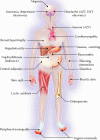Adverse effects of antiretroviral therapy for HIV infection
- PMID: 14734438
- PMCID: PMC315530
Adverse effects of antiretroviral therapy for HIV infection
Abstract
Long-term remission of HIV-1 disease can be readily achieved by combinations of antiretroviral agents. The suppression of plasma viral loads to less than the limit of quantification of the most sensitive commercially available assays (i.e., less than 50 copies/mL) and the coincident improvement in CD4 T cell counts is associated with resolution of established opportunistic infections and a decrease in the risk of new opportunistic infections. However, prolonged treatment with combination regimens can be difficult to sustain because of problems with adherence and toxic effects. All antiretroviral drugs can have both short-term and long-term adverse events. The risk of specific side effects varies from drug to drug, from drug class to drug class, and from patient to patient. A better understanding of the adverse effects of antiretroviral agents is of interest not only for HIV specialists as they try to optimize therapy, but also for other physicians who care for HIV-positive patients.
Figures




References
-
- Palella FJ Jr, Delaney KM, Moorman AC, Loveless MO, Fuhre J, Satten GA, et al. Declining morbidity and mortality among patients with advanced human immunodeficiency virus infection. HIV Outpatient Study Investigators. N Engl J Med 1998;338:853-60. - PubMed
-
- Detels R, Munoz A, McFarlane G, Kingsley LA, Margolick JB, Giorgi J, et al. Effectiveness of potent antiretroviral therapy on time to AIDS and death in men with known HIV infection duration. AIDS Cohort Study Investigators. JAMA 1998;280:1497-503. - PubMed
-
- d'Arminio Monforte A, Lepri AC, Rezza G, Pezzotti P, Antinori A, Phillips AN, et al. Insights into the reasons for discontinuation of the first highly active antiretroviral therapy (HAART) regimen in a cohort of antiretroviral naïve patients. I.C.O.N.A. Study Group. Italian Cohort of Antiretroviral-Naïve Patients. AIDS 2000;14:499-507. - PubMed
-
- Lucas GM, Chaisson RE, Moore RD. Highly active antiretroviral therapy in a large urban clinic: risk factors for virologic failure and adverse drug reactions. Ann Intern Med 1999;131:81-7. - PubMed
Publication types
MeSH terms
Substances
LinkOut - more resources
Full Text Sources
Medical
Research Materials
